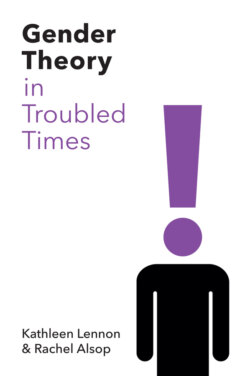Читать книгу Gender Theory in Troubled Times - Rachel Alsop - Страница 7
Introduction What is gender?
ОглавлениеThis book is about theorizing gender. So, what is gender? When we were writing Theorizing Gender, at the end of the 1990s, the term gender was associated primarily with the psychological, behavioural and social aspects of being a man or a woman, or someone who refuses that binary. It was contrasted with the term sex, which, by many, was taken to be a marker of biological difference. In terms of the famous sex/gender distinction (which we discuss in chapter 1), sexed difference was considered as something biological (often characterized as being male or female) but gender was viewed as socially constructed, variable historically, as well as cross- and intra-culturally, and susceptible to change.
Much has happened to all the terms since then.
Theoretically, the sex/gender distinction has been further problematized (see chapter 1). The apparent givenness of biology in some accounts has been destabilized by feminist biologists, among others, and the necessity of a binary biological division into male and female challenged as itself mediated by cultural assumptions about gender and by norms of heterosexuality. On the other side, the body has been seen as central to the psychological, behavioural and social aspects of being a man or a woman. Gender cannot be pruned off as simply a matter of style. What might be considered a question of style is femininity and masculinity. Femininity would here be considered the modes of appearance and behaviour which are normatively linked, in a specific context, to being a woman, masculinity what is normatively linked to being a man.
Secondly, widely, within English-speaking countries, the term ‘gender’ has come to stand for a positioning of oneself or others as a ‘man’ or a ‘woman’, or as ‘non-binary’, without reference to the sex/gender distinction and without commitment as to whether this positioning is biological or social. It is the term used in the media and often on official forms. When your gender is asked for, what is meant is ‘Are you a man or a woman?’, with the occasional option of additional categories such as non-binary. And, to complicate matters further, the terms ‘being a man’ or ‘being a woman’ are generally used synonymously with ‘being male’ or ‘being female’, although, for some, these latter terms still carry something of their biological history.
Thirdly, the Gender Recognition Act in the UK (2004), and parallel legislation elsewhere, allows someone to change their initial assignment as man or woman, male or female, similarly without commitment to these categories being either social or biological.
What we are exploring, in this book, is the practice of differentiating people according to sexed categories, as men or women, or categories which reference this dominant binary. We could have used the terms ‘sexed difference’ or ‘sexual difference’ for this task. The latter, as we clarify in chapter 2, is associated with a particular psychoanalytically anchored theory and so was not suitable for us. We could, however, describe our enterprise as theorizing ‘sexed difference’, a term we regard as synonymous with gender. We are using ‘gender’ here, as is now widespread, to mean being positioned in relation to the categories ‘man’ or ‘woman’, a process of which we are attempting to make sense. Since the publication of Judith Butler’s Gender Trouble in 1990 (discussed in chapter 6), work exploring this process has been referred to as ‘gender theory’. That is the topic of this book.
